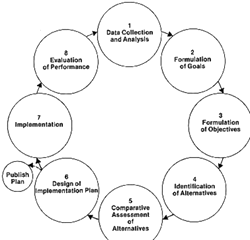 Back | Next
Back | Next

Topic
4
Slide
Show:
Strategic Planning
Powerpoint
presentation (in Adobe Presenter format) Click "Notes" for author's description of slides. It is suggested that you set the main slide controller (in the bar under the slide) to ">" / stop, instead of "||" and advance the slides manually using the ">|" and "|<" buttons.
Conducting a Neighborhood Strategic Plan
Powerpoint
presentation (in Adobe Presenter format) Click "Notes" for author's description of slides. It is suggested that you set the main slide controller (in the bar under the slide) to ">" / stop, instead of "||" and advance the slides manually using the ">|" and "|<" buttons.
"Ultimately
it is the planning process, not the plan document, that brings about
development". Neighborhood strategic planning can unify diverse
community development activities such as in education, housing,
economic development, and public safety through long term vision,
goals, conditions assessments, strategies, objectives, and programs.
The approach here is that community development begins with a comprehensive perspective that is consistent with the connection of all neighborhood elements. Without this approach, community development efforts are quite likely to fail. The planning process described in the Conducting a Neighborhood Strategic Plan slide show, above, was used with the O’Fallon neighborhood in Saint Louis in 2011. This planning effort was carried out in a graduate-level course in social work at Washington University.
Taking a comprehensive approach is complex and can seem abstract and of little impact. However, it allows residents to share a broad understanding of the community, to clarify options for action, and to make better choices on short-term and long-term projects. And when the process is sensitively facilitated, it is informed by community knowledge of the neighborhood. We understand that community building mainly occurs not as a direct result of the plan but through the action that follows to implement it.
We emphasize that the plan must be “owned” by the neighborhood, it has to be directed by residents and leaders, and it requires neighborhood action to be implemented. We were in O’Fallon to assist. The approach used is summarized by Mike Green from the ABCD (Asset Based Community Development) Training Group: the community must be “motivated by what you don’t have, to use what you have, to create what you want, by working together”. This is a shorthand way to describe social capital.
Through the involvement of neighborhood residents, a community-directed set of long-term Vision Statements and desired Outcomes, priority Strategies, and Programs were established for O’Fallon. These covered economic development and jobs; community schools and education; public safety and fear of crime; social services, informal helping, and health; housing and affordable housing; and the neighborhood’s physical environment. The Strategies and Programs identified provided central roles for neighborhood residents. The plan itself is found here: O’Fallon Neighborhood Community Development Plan
.
. |
|

While using neighborhood assets is the most important, effective community organizations also must have strong, direct working relationships with service agencies, businesses, and funding sources located outside the neighborhood. Based on the neighborhood Outcomes, more than 50 possible external partners were interviewed for the O’Fallon plan. The interview findings are starting points for the O’Fallon Community Development Organization to draw on external resources. The surveys were compiled in a second document: O’Fallon Neighborhood Community Development Plan - Agency Interviews
.
Short-term implementation projects follow the strategic plan. In our work, graduate-level social work students were paired with O’Fallon neighborhood committees to provide technical assistance and organizing support over the following months. This engagement is critical for effective neighborhood action.
Some neighborhood Outcomes are more technical than others: in O’Fallon this included projects to develop housing and affordable housing to fill the gaps left by abandonment, and to revitalize the neighborhood’s commercial center. A second course was conducted with Washington University social work and architecture students to advance these longer-term projects. The resulting plans are found on this web site under Topic 7, Building Community with Land Use Planning and Zoning
Selected
Readings (pdf)
Strategic Planning
Subtopics inside:
Community plans
Strategic planning
Readings:
Ch. 8 "Forging an Organizational Plan",
in Murphy and Cunningham, Organizing for Community Controlled
Development, pp. 154-177.
Reading
#1
Ch.
9 "Unity in Creating a Comprehensive Community Plan",
in Murphy and Cunningham, Organizing for Community Controlled
Development, pp. 178-199.
Reading
#2
Avron
Bendavid-Val, Local Economic Development Planning: From Goals
to Projects, American Planning Association, PAS Planning
Advisory Services, Report No. 353, 1980, Chapters 1 - 8.
Reading
#6 (pdf)
Dolores
Delahanty and G. Lawrence Atkins, Strategic Local Planning:
a Collaborative Model, Project Share, Human Services Monograph
Series, National Clearinghouse for Improving the Management of Human
Services, Number 23, July 1981. "Considerations for Plan Implementation",
"Conceptual Design and Development". "The Planning
Model Components", pp. 29-61.
Reading
#7 (pdf)
NOTE:
If you have difficulty in opening your readings, you may need to
download Adobe
Acrobat Reader.
This is a free download and simple installation. Please follow the
instructions at the official Adobe
website.
|


